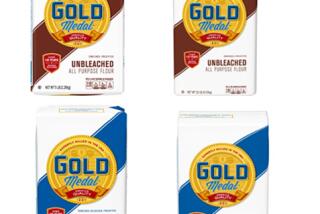Fist bumps, high-fives spread fewer germs than handshakes, study says
To fight the spread of germs, doctors should ditch the handshake and greet their patients with a fist bump instead, a new study says.
Through a series of tests, researchers at the Institute of Biological, Environmental and Rural Sciences at Aberystwyth University in Wales documented that fist bumps are 20 times more hygienic than handshakes. They are also 10 times cleaner than high-fives, according to results published online Monday in the American Journal of Infection Control.
Volunteers donned sterile gloves and dunked their hands into a soup of de-fanged Escherichia coli bacteria. Then they shook hands, high-fived or fist-bumped with one another.
The handshakes transferred an average of 124 million colony-forming units of E. coli. That was almost twice as high as for high-fives and about 20 times more than with fist bumps, Sara Mela and David E. Whitworth discovered.
In part, this was due to the large contact area of handshakes (24.4 square inches, on average). The greater the contact area, the more bacteria moved from hand to hand, but that wasn’t the whole story, the researchers reported.
For instance, the duration of the greeting matters. Handshakes last longer – 3 seconds – than high-fives or fist bumps. When fist bumps were prolonged to 3 seconds, more E. coli spread from hand to hand. (However, lengthening a high-five didn’t make it any germier.)
There’s also the pressure between hands during a greeting. Mela and Whitworth used an instrument called a dynamometer to measure the grip strength of various handshakes and found that those of “moderate strength” transferred fewer bacteria than “strong” handshakes.
The researchers didn’t conduct their tests with any pathogens that were actually dangerous, but they wrote that they would probably get similar results if they had tested flu virus particles or “other pathogenic microorganisms.”
In the real world, where people aren’t walking around in sterile gloves, the fist bump and high-five might fare better or worse than a handshake because “different parts of a hand would have differing amounts of bacterial fauna,” Mela and Whitworth said.
“For the sake of improving public health we encourage further adoption of the fist bump as a simple, free and more hygienic alternative to the handshake,” they concluded.
Indeed, there is some evidence that fist bumps spread fewer germs than handshakes under actual hospital conditions.
In a pilot study, researchers from West Virginia University asked two healthcare workers to make their way from a hospital lobby to a surgical ward on the fifth floor. Along the way, the volunteers pushed elevator buttons, used door handles and touched other potentially germy surfaces.
Once they got to the surgical floor, they each shook hands with 20 other healthcare workers who didn’t know what the researchers were trying to measure. The 20 handshakers were asked to wash their hands, then placed their “clean” hands in a microbiological growth medium to see how many germs survived.
Then the whole experiment was repeated, this time with the two healthcare workers greeting their colleagues with fist bumps instead of handshakes. (They followed the exact same route from the hospital lobby to the surgical ward.) The 20 fist bump recipients then washed their hands and placed their fists in the growth medium.
The West Virginia researchers found that the people who shook hands had four times as many pathogens on their hands as the people who fist-bumped, according to results published last year in the Journal of Hospital Infection.
But getting doctors to switch from handshakes to fist bumps won’t be easy. Studies have shown that patients feel more calm after shaking hands with their doctor, and some hospitals encourage physicians to greet patients this way to promote a sense of empathy.
In an essay published last month in the Journal of the American Medical Assn., experts from UCLA reminded readers that smoking was once commonplace in hospitals too. But times change, and the growing emphasis on finding “innovative, practical and fiscally prudent approaches toward the prevention of disease” could someday make handshakes as unpopular as cigarettes.
They even suggested that hospitals, clinics and other healthcare facilities post signs with messages like this:
“Handshake-free zone: to protect your health and the health of those around you, please refrain from shaking hands while on these premises.”
For more discoveries from the world of science and medicine, follow me on Twitter @LATkarenkaplan and “like” Los Angeles Times Science & Health on Facebook.







